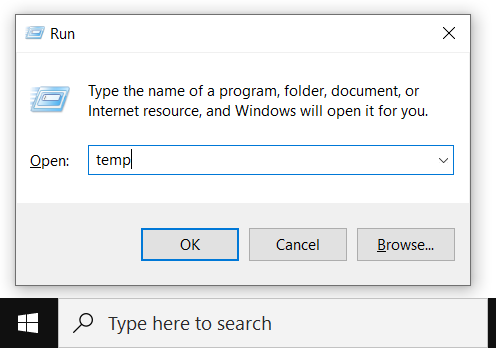

To use Storage Sense in Windows 10, go to Settings > System > Storage as described in Method 1. What’s more, you can also customize it and specify how it works automatically on your computer. Called ‘Storage Sense’, the feature is turned off by default, but you can turn it on in a few simple clicks. Windows 10 comes with a built-in service to automatically delete temporary files on a schedule. Note: If you don’t see the Recycle Bin icon on your desktop, you can get it back easily by checking out how to restore missing features in Windows 10. Note: To select individual files, hover over the filenames and click on the selection box that appears.įinally, right-click on the Recycle Bin icon on your desktop and click on ‘Empty Recycle Bin’. Select all the files and folders here by clicking on the ‘Select All’ option and press the ‘Delete’ key on your keyboard to remove all of that to the Recycle Bin.

This will open up the ‘Temp’ folder where Windows stores much of the temporary files. Open the ‘Run’ dialog box (Windows key + R) and type or copy+paste “%temp%” (without quotes). For that, go through the following steps: You can also manually delete temp files in Windows 10. Pro Tip: If you need to free up more space, you can also delete system files by clicking on the ‘Clean up System Files’ option and selecting the file types to get rid of. Then click ‘OK’ to manually delete temp files and folders. If not, you’ll automatically be taken to the next step.įrom the available options, select the file types you want to get rid of. Next, you might have to select the target disk manually from the drop-down menu (as seen below) if you have multiple physical drives or partitions.

In the search box on the taskbar, type “cleanup”, and select ‘Disk Cleanup’ from the list of results. Once the results are displayed, select the items you want to delete, and then click on ‘Remove files’. If you don’t see Temporary files listed, select ‘Show more categories’. Now, scroll down if you have to and click on ‘Temporary files’. In the next page, click on ‘Storage’ and choose the local drive that you want to cleanup. Method 1: Using System Settings #įirstly, go to Settings (Windows key + I) > System. So without further ado, let’s check out how we can remove temporary files in Windows 10. We will also tell you how you can manually delete temp files in Windows 10. For that, we will use various built-in tools such as Disk Management, Disk Cleanup, Storage Sense and more. Today, we will discuss the best and fastest ways to delete temporary files in Windows 10. Windows 10 offers you a number of different ways to delete junk files on your computer.


 0 kommentar(er)
0 kommentar(er)
